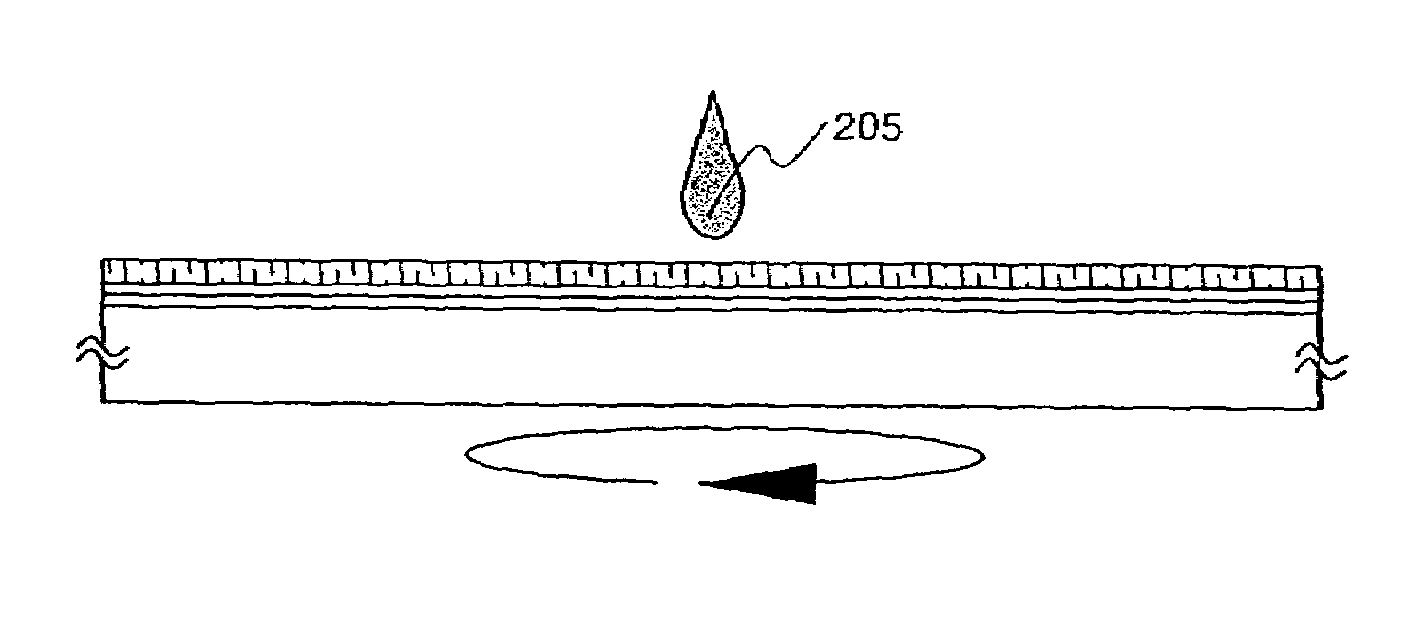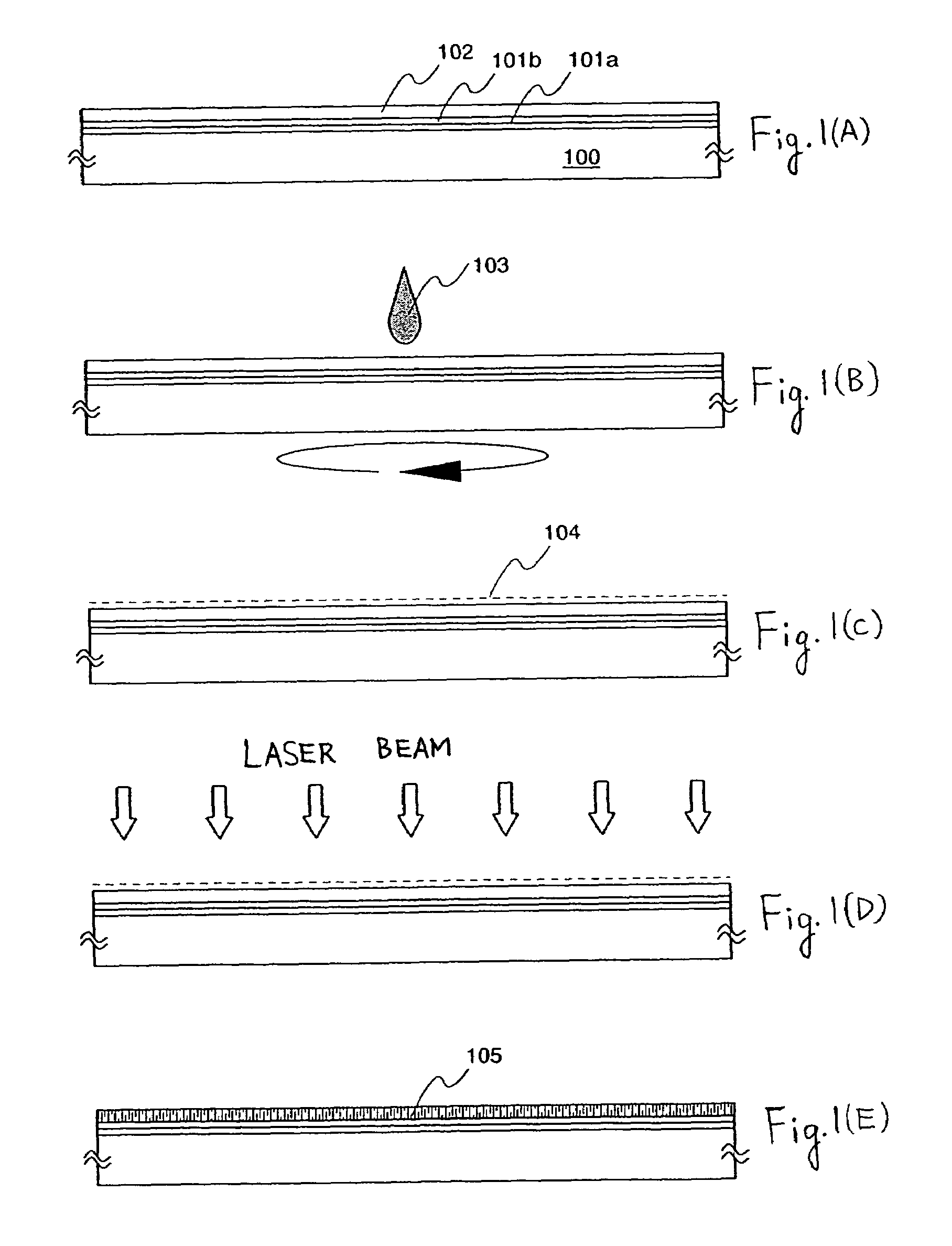Laser doping processing method and method for manufacturing semiconductor device
a technology of laser doping and processing method, which is applied in the direction of semiconductor devices, electrical devices, transistors, etc., can solve the problems of inability to accommodate wide-range doping, lack of reliability of threshold voltage, and large substrate size flowing through the fabrication process, so as to promote crystallization and promote crystallization. , excellent characteristics
- Summary
- Abstract
- Description
- Claims
- Application Information
AI Technical Summary
Benefits of technology
Problems solved by technology
Method used
Image
Examples
embodiment 1
[0039]In the present embodiment, a method of doping a semiconductor by applying thereto a liquid including a dopant and irradiating the semiconductor with laser light will be described.
[0040]A liquid including a dopant is applied with a spinner to the surface of a semiconductor to form a thin film of the liquid including the dopant. An element that creates an N-type or a P-type is used as the dopant. Representative examples of the N-type include phosphor, arsenic and antimony, and representative examples of the P-type include boron, aluminium and gallium. The concentration of the dopant in the liquid is adjusted so that a desired concentration is eventually added to the semiconductor film.
[0041]Examples of the solution liquid including the element that creates the P-type or the N-type representatively include an aqueous solution of boric acid or phosphoric acid. When these aqueous solutions are applied to the surface of the semiconductor, the wettability between the semiconductor su...
embodiment 2
[0045]In the present embodiment, a method where crystallization and laser doping are simultaneously conducted will be described using FIG. 1.
[0046]First, base insulating films 101a and 101b are formed on a substrate 100. For the substrate, an insulating substrate such as a glass substrate, a quartz substrate, crystalline glass, or a ceramic substrate, a stainless steel substrate, a metal substrate (tantalum, tungsten, molybdenum, etc.), a semiconductor substrate, or a plastic substrate (polyimide, acrylic, polyethylene terephthalate, polycarbonate, polyarylate, polyethersulfone, etc.) can be used. A substrate that is suitable in consideration of the high temperature of the process and purpose may be selected from among these.
[0047]The base insulating films 101a and 101b are formed by forming a single layer or two or more plural layers of insulating films such as a silicon oxide film, a silicon nitride film or a silicon oxide nitride film. These are formed using a known method such a...
embodiment 3
[0056]An other embodiment of the invention will be described using, FIG. 1 similar to Embodiment 2.
[0057]Similar to Embodiment 2, the base insulating films 101a and 101b are formed on the substrate 100, and the amorphous semiconductor layer 102 is formed thereon (FIG. 1(A)).
[0058]Next, an element that promotes crystallization is simultaneously incorporated, at a weight conversion of 5 to 100 ppm, in the liquid (boric acid aqueous solution) including the dopant (boron) and the liquid is applied to the amorphous semiconductor layer 102 with a spinner. In the present embodiment, nickel acetate corresponding to Ni at a weight conversion of 10 ppm is incorporated in the boric acid aqueous solution, and the thin film 104 of the liquid 103 including the dopant and Ni is formed on the amorphous semiconductor layer 102. Other examples of elements that promote crystallization include iron (Fe), palladium (Pd), tin (Sn), lead (Pb), cobalt (Co), platinum (Pt), copper (Cu) and gold (Au), but one...
PUM
 Login to View More
Login to View More Abstract
Description
Claims
Application Information
 Login to View More
Login to View More - R&D
- Intellectual Property
- Life Sciences
- Materials
- Tech Scout
- Unparalleled Data Quality
- Higher Quality Content
- 60% Fewer Hallucinations
Browse by: Latest US Patents, China's latest patents, Technical Efficacy Thesaurus, Application Domain, Technology Topic, Popular Technical Reports.
© 2025 PatSnap. All rights reserved.Legal|Privacy policy|Modern Slavery Act Transparency Statement|Sitemap|About US| Contact US: help@patsnap.com



